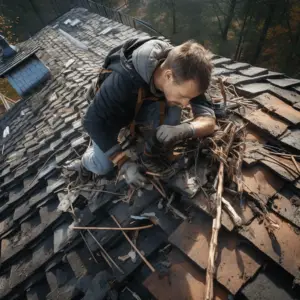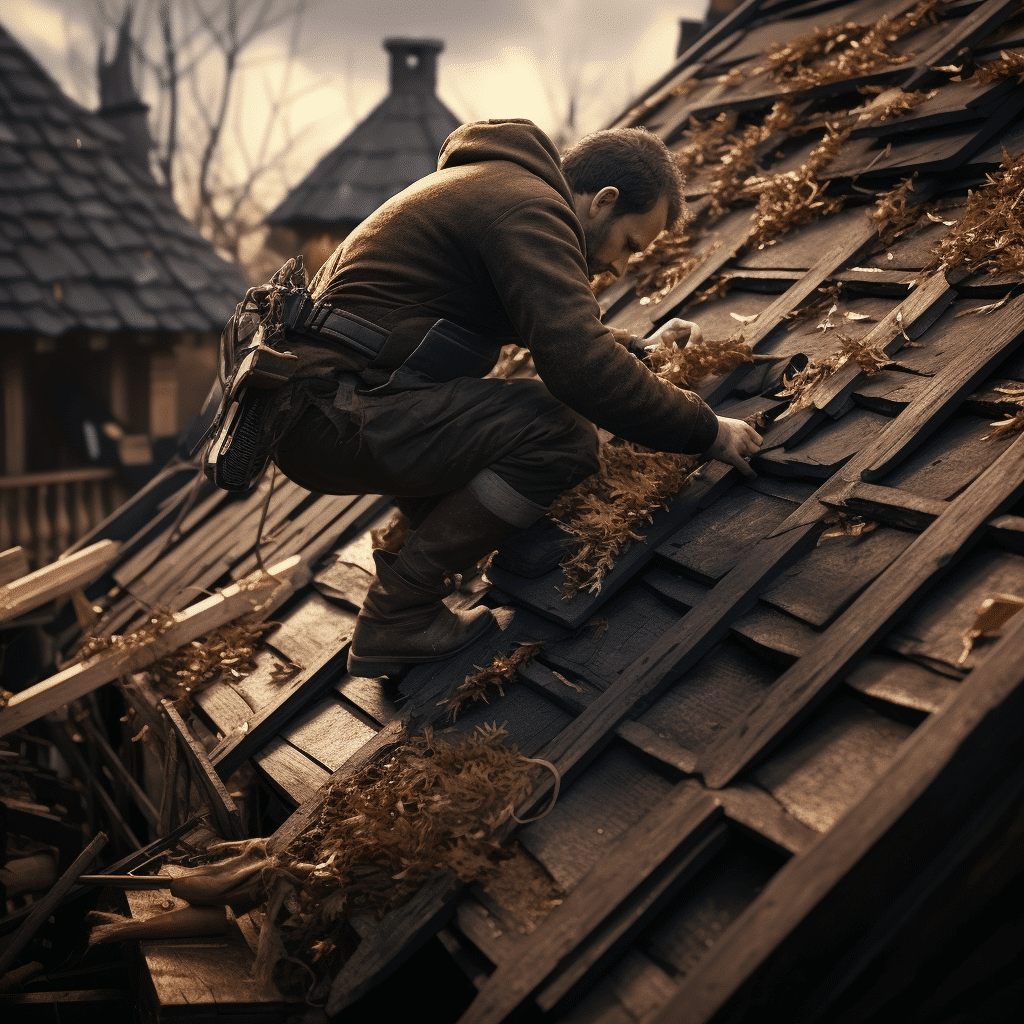Table of Contents
Common Signs of Roof Damage
Roof repair: Watch out for signs of roof damage! Missing, cracked, or curled shingles, yellowish-brown stains on walls/ceilings, a spike in energy bills, and mold growth are common indicators. Don’t ignore them – they can worsen and cause costly repairs.
Get professional roofing contractors for regular inspections and repairs. Taking proactive steps will save you money and give you peace of mind. Don’t let damaged roof compromise your home – secure a reliable roofing system now! Pick the right roofing material – one that’s storm-proof and won’t leave you stranded.
Types of Roofing Materials
Roofing materials are vital for keeping a roof’s structure and integrity. Different types exist, each offering unique benefits and characteristics. Let’s take a look at the different options available!
| Material | Description |
|---|---|
| Asphalt Shingles | Affordable, versatile, and durable. Variety of colors and styles. |
| Metal | Long lasting with excellent resistance to harsh weather. |
| Slate | Natural stone for an elegant look. Water-resistant for wet climates. |
| Wood | Adds a unique charm, but requires maintenance. Ideal for traditional homes. |
| Tile | Clay or concrete tiles are durable and energy efficient. Aesthetic designs. |
Eco-friendly materials are there too, like recycled or sustainable roofing. These help reduce environmental impact while still protecting the roof.
When picking roofing materials, consider budget, climate, maintenance, and style. A professional roofer can guide you to the best option for your needs. Quality is key: invest in high-quality materials to ensure your roof’s safety and longevity. Don’t forget to inspect and maintain it regularly!
Steps to Assess Roof Repair Needs

Assess the need for roof repairs? It’s simple! Systematically take all the necessary steps. Follow these guidelines to figure out the extent of the damage and the right action plan.
- Check your Roof: Start by viewing the roof from the ground. Look for signs of damage like missing or damaged shingles, sagging areas, or loose flashing. Note down any potential problem spots that need a closer inspection.
- Do a Detailed Check: Climb onto the roof with a ladder and conduct a thorough examination. Check for cracked or curled shingles, rusted or loose flashing, and areas where water could be pooling. Inspect all parts of the roof, like gutters, vents, and chimney, for wear and tear.
- Consult the Pros: If there’s significant damage or uncertainty on the severity, it’s best to get in touch with a professional roofing contractor. They know the best and can accurately assess your roof and provide advice on repair or replacement.
On top of this, take preventive measures to avoid future damage. Clean your gutters regularly. Remove debris from the roof. This’ll prevent water accumulation and extend the roof’s life.
Timely assessing your roof’s needs saves you from costly repairs. Follow these steps and seek expert advice when needed – and your roof will stay in good condition for years to come.
Essential Tools and Materials for DIY Roof Repair
Tools and materials are a must for a successful DIY roof repair. Here’s your checklist:
- Ladder: For safe and comfortable access to the roof.
- Roofing shingles: Durable materials that protect against weather.
- Hammer: Quality one to secure nails in place.
- Safety goggles: To protect eyes from hazards.
- Roofing nails: Sturdy and corrosion-resistant.
- Tarps or plastic sheeting: To protect from rain and elements.
For success, keep in mind:
Don’t use materials or tools not made for roofing. Measure twice to get a precise fit.
To maximize these tools and materials:
Use a ladder that extends 3 feet above the edge of the roof. Choose shingles with high wind resistance ratings. Follow manufacturer instructions for tarps or plastic sheeting.
These tools and materials will make roof repairs easier and help your roof last. Safety first, so proceed with caution and get professional help if needed. Get a contractor for superhero results, without the costume or superpowers!
Hiring a Professional Roofing Contractor
For the safety and longevity of your roof, hiring a professional roofing contractor is key. They have the expertise, experience, and tools to complete any roofing project. Here are some points to keep in mind when you hire a pro:
- Verify Credentials: Before hiring a roofer, make sure their credentials are verified. Check licenses, certifications, and insurance coverage. This will make sure you’re dealing with a reliable professional.
- Experience Matters: Experience is important in determining the quality of work. Look for contractors with a lot of experience in similar projects. Their expertise will guarantee a perfect roof.
- Recommendations: Ask friends and family who recently hired roofers. Their experiences will give you an idea of the quality and customer service offered by different contractors.
- Get Estimates: Get written estimates from multiple contractors before deciding. The estimates should include materials, labor charges, timeline, warranty, and any additional services.
When hiring a professional roofer, every detail matters. Check credentials, get recommendations, and get detailed estimates. This will help you make an informed decision.
I had a really bad storm once. My roof was damaged and I needed help. I found a roofing contractor based on my neighbor’s referrals. They quickly assessed the damage and provided a plan. Then, they worked hard and kept me updated. The end result surpassed my expectations in terms of craftsmanship and durability.
Hiring a professional roofing contractor is an investment in your roof. By following these guidelines and getting recommendations, you can trust this job to someone capable. This way, you’ll get a secure and long-lasting roof.
Cost Analysis: DIY vs. Hiring a Professional
Repairing a roof can be tricky. So, let’s look at the cost of DIY versus hiring a pro. Here’s a breakdown:
| Cost | DIY | Hiring a Professional |
|---|---|---|
| Labor | $0 | Varies |
| Materials | $500-800 | Varies |
| Tools | $100-200 | Included in labor cost |
DIY may save you money on labor costs. But, you’ll need to buy materials and tools. Pros have years of experience. So, their expertise ensures the job is done well and minimizes mistakes.
Pro Tip: Evaluate your skills and confidence before deciding. If you have prior experience and are confident in your abilities, DIY can be cost-effective. Otherwise, hire a professional for quality work. Oh, and don’t forget – it’s the landing that really gets your attention!
Safety Precautions during Roof Repair
Safety is key when repairing a roof. Follow these 5 tips to stay safe:
- Clear the Work Area: Before starting, remove debris and loose shingles. Minimize risk of tripping or slipping.
- Wear Protective Gear: Hard hat, safety goggles, and non-slip footwear shield against falling objects and provide stability.
- Use Proper Ladders & Scaffolding: Set up correctly and securely. Check for damage or instability. Use a harness system at heights.
- Be Aware of Electrical Hazards: Turn off all electricity in the area. Consult a professional if electrical work is required.
- Stay Alert to Weather Conditions: Monitor changing weather conditions. Postpone repairs if conditions become unfavorable.
Stay safe and remember that unique details should be considered for a successful roof repair project. These may include proper ventilation to avoid toxic fumes or adequate sunlight for visibility.
Preventive Measures to Extend the Lifespan of Your Roof

It’s key to take measures to ensure your roof lasts. Regular inspections, cleaning gutters, trimming trees, proper ventilation & professional maintenance are all essential. High-quality materials from reputable suppliers is also a must. A study by NRCA shows regular maintenance can add up to 50% longer life to a roof. Roof repair FAQs can help owners out too!
FAQ: Frequently Asked Questions about Roof Repair
Fixing the roof can be a tricky challenge. Here are some common questions about roof repair:
- How can I tell if my roof needs repair?
- What are the signs of roof damage?
- Can I do it myself or should I hire an expert?
- How much does a roof repair cost?
- How long does a fixed roof last?
- Are there any ways to stop future roof damage?
It’s essential to remember each roof is different, so it’s best to ask a pro for the right assessment and advice.
Plus, regular maintenance and check-ups can help avoid costly repairs in the future. Buying quality materials also helps increase the lifespan of your repaired roof.
Pro Tip: When selecting a contractor for roof repair, always look at their credentials, ask for references and make sure they give a written estimate before beginning any work.
Conclusion: Secure Your Roof – Don’t let your roof become a soggy mess; patch it up and keep your home dry and safe!
Conclusion: Maintaining the Integrity of Your Roof
Maintaining your roof’s integrity is key for its longevity. Regularly inspect for damage and address repairs quickly. Cleanliness and proper ventilation also help.
Inspections mean looking for cracks, missing shingles, leak stains, wear and tear. Areas like chimney and vent flashing must be watched. Don’t neglect minor issues; bigger ones may require costly roof replacement.
Removing leaves, branches, and moss prevents moisture buildup which erodes materials. Ventilation promotes air circulation, inhibiting heat-related damage and mold/mildew. Neglecting maintenance can lead to severe consequences.
Caring for roofs is important for long-term safety and protection.

